too的用法
- 格式:ppt
- 大小:15.50 KB
- 文档页数:7
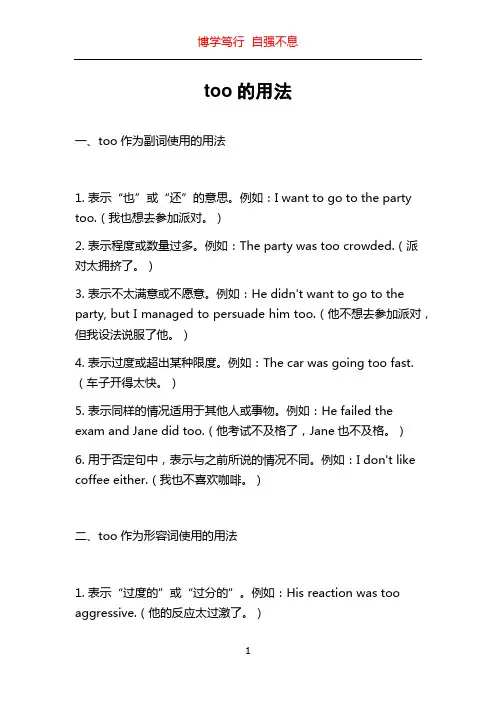
too的用法一、too作为副词使用的用法1. 表示“也”或“还”的意思。
例如:I want to go to the party too.(我也想去参加派对。
)2. 表示程度或数量过多。
例如:The party was too crowded.(派对太拥挤了。
)3. 表示不太满意或不愿意。
例如:He didn't want to go to the party, but I managed to persuade him too.(他不想去参加派对,但我设法说服了他。
)4. 表示过度或超出某种限度。
例如:The car was going too fast.(车子开得太快。
)5. 表示同样的情况适用于其他人或事物。
例如:He failed the exam and Jane did too.(他考试不及格了,Jane也不及格。
)6. 用于否定句中,表示与之前所说的情况不同。
例如:I don't like coffee either.(我也不喜欢咖啡。
)二、too作为形容词使用的用法1. 表示“过度的”或“过分的”。
例如:His reaction was too aggressive.(他的反应太过激了。
)2. 表示“特别的”或“特殊的”。
例如:She's always been too ambitious for her own good.(她总是过于野心勃勃,不顾自身利益。
)三、too的其他用法1. 在too...to...结构中,表示某事太过于某种程度而无法实现另一种程度。
例如:He is too young to drive.(他年纪太小,不能开车。
)2. 在夸奖某人时,可以使用“too good”的形式。
例如:You're too good!(你太棒了!)总结:在日常英语中,too是一个常见的副词,用来表示“也”、“还”、“过度的”或“过分的”等意思。
它可以用于肯定句、否定句和问句中,并且可以作为副词或形容词使用。
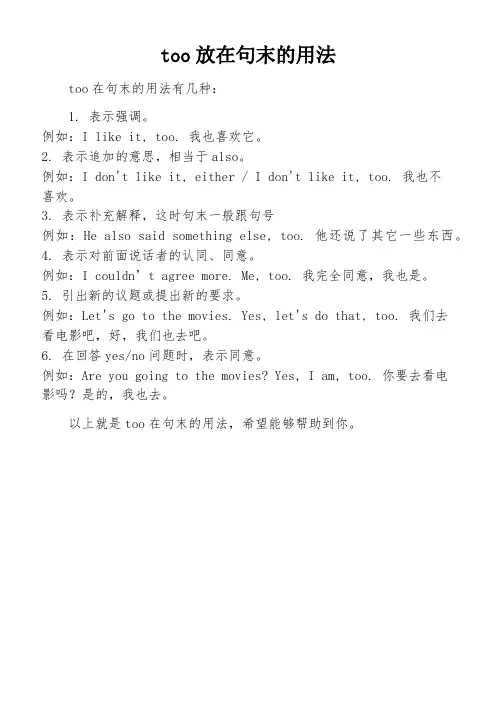
too放在句末的用法
too在句末的用法有几种:
1. 表示强调。
例如:I like it, too. 我也喜欢它。
2. 表示追加的意思,相当于also。
例如:I don't like it, either / I don't like it, too. 我也不
喜欢。
3. 表示补充解释,这时句末一般跟句号
例如:He also said something else, too. 他还说了其它一些东西。
4. 表示对前面说话者的认同、同意。
例如:I couldn’t agree more. Me, too. 我完全同意,我也是。
5. 引出新的议题或提出新的要求。
例如:Let's go to the movies. Yes, let's do that, too. 我们去
看电影吧,好,我们也去吧。
6. 在回答yes/no问题时,表示同意。
例如:Are you going to the movies? Yes, I am, too. 你要去看电
影吗?是的,我也去。
以上就是too在句末的用法,希望能够帮助到你。
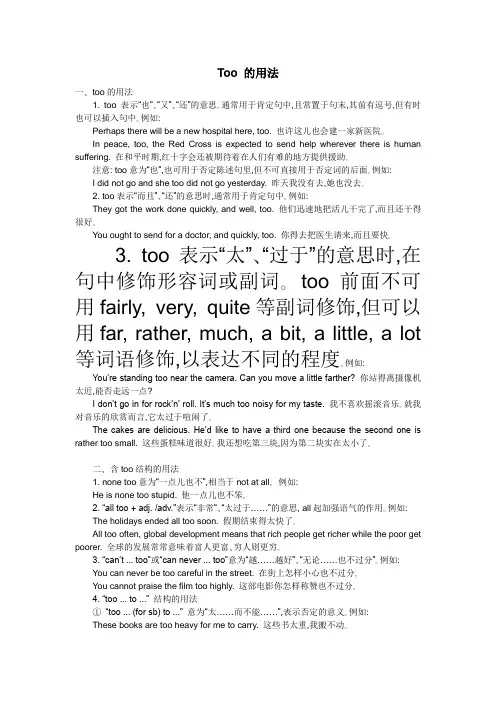
Too 的用法一、too的用法1. too表示“也”、“又”、“还”的意思。通常用于肯定句中,且常置于句末,其前有逗号,但有时也可以插入句中。例如:Perhaps there will be a new hospital here, too. 也许这儿也会建一家新医院。In peace, too, the Red Cross is expected to send help wherever there is human suffering. 在和平时期,红十字会还被期待着在人们有难的地方提供援助。注意: too意为“也”,也可用于否定陈述句里,但不可直接用于否定词的后面。例如:I did not go and she too did not go yesterday. 昨天我没有去,她也没去。2. too表示“而且”、“还”的意思时,通常用于肯定句中。例如:They got the work done quickly, and well, too. 他们迅速地把活儿干完了,而且还干得很好。You ought to send for a doctor, and quickly, too. 你得去把医生请来,而且要快。3. too表示“太”、“过于”的意思时,在句中修饰形容词或副词。too前面不可用fairly, very, quite等副词修饰,但可以用far, rather, much, a bit, a little, a lot 等词语修饰,以表达不同的程度。例如: You’re standing too near the camera. Can you move a little farther? 你站得离摄像机太近,能否走远一点?I don’t go in for rock’n’ roll. It’s much too noisy for my taste. 我不喜欢摇滚音乐。就我对音乐的欣赏而言,它太过于喧闹了。The cakes are delicious. He’d like to have a third one because the second one is rather too small. 这些蛋糕味道很好。我还想吃第三块,因为第二块实在太小了。二、含too结构的用法1. none too意为“一点儿也不”,相当于not at all。例如:He is none too stupid. 他一点儿也不笨。2. “all too + adj. /adv.”表示“非常”、“太过于……”的意思, all起加强语气的作用。例如:The holidays ended all too soon. 假期结束得太快了。All too often, global development means that rich people get richer while the poor get poorer. 全球的发展常常意味着富人更富、穷人则更穷。3. “can’t ... too”或“can never ... too”意为“越……越好”、“无论……也不过分”。例如:You can never be too careful in the street. 在街上怎样小心也不过分。You cannot praise the film too highly. 这部电影你怎样称赞也不过分。4. “too ... to ...” 结构的用法①“too ... (for sb) to ...” 意为“太……而不能……”,表示否定的意义。例如:These books are too heavy for me to carry. 这些书太重,我搬不动。The child is too young to go to school. 这小孩太小,还不能上学。注意: “too ... to ...” 结构还可以用“too + 形容词+ a/an + 名词(+ to)”结构替换,此时,要注意冠词a/an的位置。例如:This is too difficult a book for you to read. 这本书太难,你读不了。②当too前有否定词never或not时, “never/not too ... to ...”表示“不太……所以能……”的意思,其中的双重否定表示肯定意义。例如:I don’t think Peter is too young to take care of the pet dog properly. (该句too前面的not已经进行了否定转移) 我认为彼特不小了,他能适当地照料宠物狗了。One is never too old to learn. 活到老,学到老。③当too前有only/but/just/all修饰时, “only/but/just/all too ... to ...”表示“非常乐意……”的肯定意义。例如:We are but too glad to help you. 我们非常高兴地帮助你。We’re only too pleased to watch the TV play. 我们非常喜欢看这部电视剧。④当“too ... to ...” 结构中的形容词为anxious, delighted, easy, eager, exciting, glad, good, happy, interesting, kind, nice, pleased, ready, satisfied, willing等词语时, “too ... to ...” 结构表示肯定意义,意为“非常……”、“十分……”。例如:She had made that special dress the night before and was too anxious to try it on. 她前天晚上已做好了那件特别的衣服,十分急着要试穿。Jennifer is too ready to help others. 詹妮弗非常乐于帮助别人。⑤当在to前面加not构成“too ... not to ...” 结构时,表示肯定意义,意为“非常……而不会……”。例如:I’m sure that she is too diligent not to fail in the exam. 我敢肯定她很勤奋,必定能通过这次考试。He is too careful not to have noticed it. 他那么仔细,不会没有注意到这一点的。三、much too与too much的区别1. too much意为“太多”,在句中可作宾语、状语和定语。例如:You’re drinking too much. 你喝得太多了。Victor certainly cares too much about himself. 维克多确实太在乎自己了。Being exposed to sunlight for too much time will do harm to one’s skin. 长时间曝露在阳光下会对人的皮肤有害。2. much too是副词短语,用来修饰其他形容词或副词,意为“太”、“非常”。例如:The math problem is much too difficult for me. 这道数学题对我来说实在太难了。You are much too kind to me. 你对我实在太好了。。
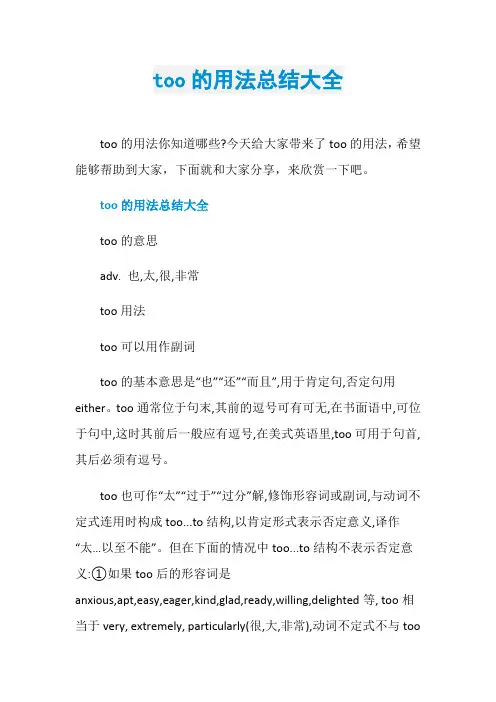
too的用法总结大全too的用法你知道哪些?今天给大家带来了too的用法,希望能够帮助到大家,下面就和大家分享,来欣赏一下吧。
too的用法总结大全too的意思adv. 也,太,很,非常too用法too可以用作副词too的基本意思是“也”“还”“而且”,用于肯定句,否定句用either。
too通常位于句末,其前的逗号可有可无,在书面语中,可位于句中,这时其前后一般应有逗号,在美式英语里,too可用于句首,其后必须有逗号。
too也可作“太”“过于”“过分”解,修饰形容词或副词,与动词不定式连用时构成too...to结构,以肯定形式表示否定意义,译作“太…以至不能”。
但在下面的情况中too...to结构不表示否定意义:①如果too后的形容词是anxious,apt,easy,eager,kind,glad,ready,willing,delighted等, too相当于very, extremely, particularly(很,大,非常),动词不定式不与too呼应而是修饰形容词,因而表示肯定意义; ②too前有only,but,all 等词时,便没有否定的意思; ③too前如有not, never的too...to结构不表示否定意义, not, never否定谓语动词,构成双重否定,因而表示肯定意义,作“并不(太)…所以能…”解; ④如不定式前有not时too...not to结构也不表示否定意义,是双重否定表示肯定意义,作“太…(很、非常)…不会〔能〕不…”解; ⑤如果该结构中有两个动词不定式,那么前一个用来修饰形容词,表示肯定意义,后一个用来修饰副词too,表示结果,表否定意义。
too作“非常,很”解时,常用于口语中,相当于very。
too用作副词的用法例句I will go, provided that you go too.你也去的话我就去。
Its too early for getting up.现在起床还太早。
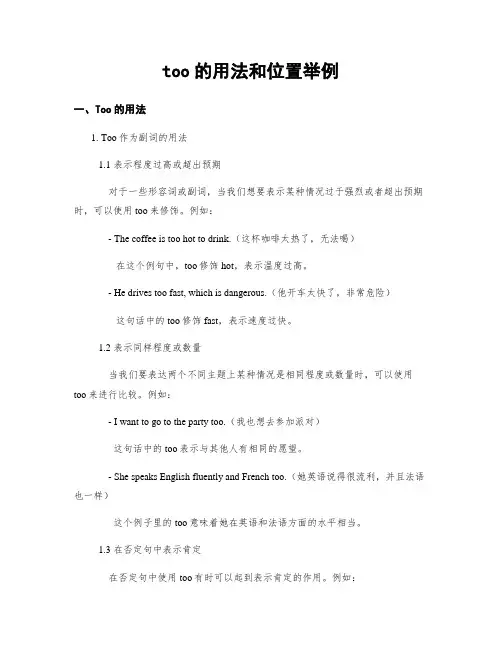
too的用法和位置举例一、Too的用法1. Too作为副词的用法1.1 表示程度过高或超出预期对于一些形容词或副词,当我们想要表示某种情况过于强烈或者超出预期时,可以使用too来修饰。
例如:- The coffee is too hot to drink.(这杯咖啡太热了,无法喝)在这个例句中,too修饰hot,表示温度过高。
- He drives too fast, which is dangerous.(他开车太快了,非常危险)这句话中的too修饰fast,表示速度过快。
1.2 表示同样程度或数量当我们要表达两个不同主题上某种情况是相同程度或数量时,可以使用too来进行比较。
例如:- I want to go to the party too.(我也想去参加派对)这句话中的too表示与其他人有相同的愿望。
- She speaks English fluently and French too.(她英语说得很流利,并且法语也一样)这个例子里的too意味着她在英语和法语方面的水平相当。
1.3 在否定句中表示肯定在否定句中使用too有时可以起到表示肯定的作用。
例如:- I don't like coffee. He doesn't either.(我不喜欢咖啡,他也不喜欢)这个例子中,too用于否定句中,表示与前者保持一致。
2. Too作为形容词的用法2.1 表示过多或超出需要当我们想要表达某物数量或程度超过了所需时,使用too作为形容词修饰名词。
例如:- There are too many people in the room.(房间里有太多的人)too修饰many,表示数量超过了合理范围。
- The suitcase is too heavy for me to carry.(这个行李箱太重了,我无法搬动)在这个例句里,too修饰heavy,表示重量超出了承受能力。
3. Too作为连词的用法3.1 表示结果或影响当我们想要表达一个行动、情况或事件的结果或影响时,可以使用too作为连词连接两个完整的句子。
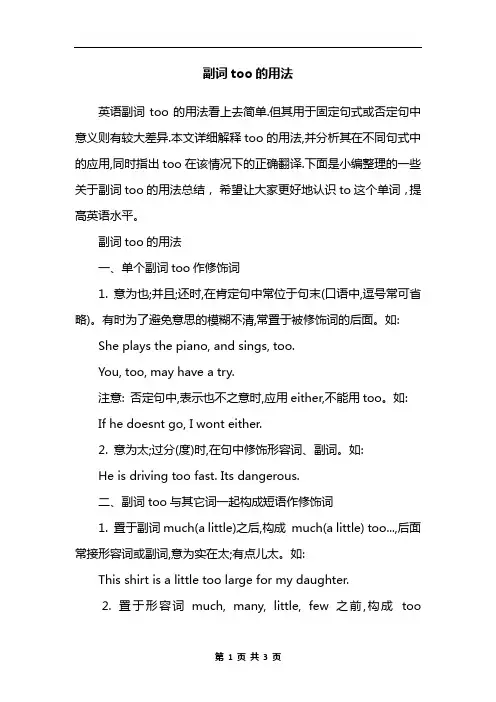
副词too的用法英语副词too的用法看上去简单.但其用于固定句式或否定句中意义则有较大差异.本文详细解释too的用法,并分析其在不同句式中的应用,同时指出too在该情况下的正确翻译.下面是小编整理的一些关于副词too的用法总结,希望让大家更好地认识to这个单词,提高英语水平。
副词too的用法一、单个副词too作修饰词1. 意为也;并且;还时,在肯定句中常位于句末(口语中,逗号常可省略)。
有时为了避免意思的模糊不清,常置于被修饰词的后面。
如: She plays the piano, and sings, too.You, too, may have a try.注意: 否定句中,表示也不之意时,应用either,不能用too。
如:If he doesnt go, I wont either.2. 意为太;过分(度)时,在句中修饰形容词、副词。
如:He is driving too fast. Its dangerous.二、副词too与其它词一起构成短语作修饰词1. 置于副词much(a little)之后,构成much(a little) too...,后面常接形容词或副词,意为实在太;有点儿太。
如:This shirt is a little too large for my daughter.2. 置于形容词much, many, little, few之前,构成toomany(few)+复数名词,too much(little)+不可数名词结构,意为太多(少)。
如:We have too many things to do at present.注意: too many(much, few, little)也可作名词短语,在句中作主语或宾语。
如:Too many of the trees have been cut down these years.3. 与不定式to do(not to do)连用,构成too...to do(not to do) sth.,意为太以至于不(以至于不会不)。
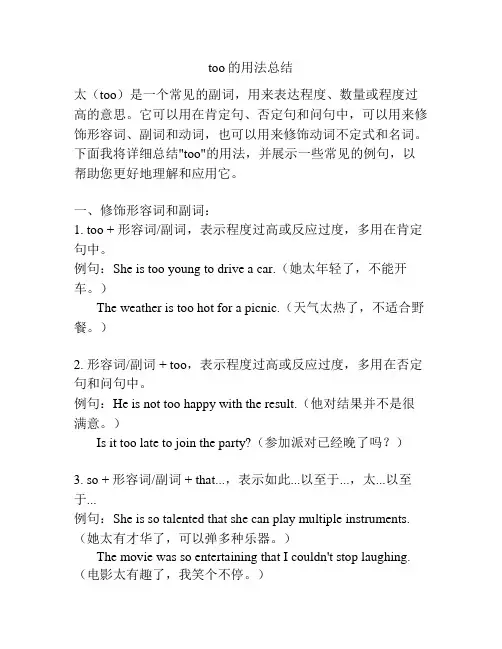
too的用法总结太(too)是一个常见的副词,用来表达程度、数量或程度过高的意思。
它可以用在肯定句、否定句和问句中,可以用来修饰形容词、副词和动词,也可以用来修饰动词不定式和名词。
下面我将详细总结"too"的用法,并展示一些常见的例句,以帮助您更好地理解和应用它。
一、修饰形容词和副词:1. too + 形容词/副词,表示程度过高或反应过度,多用在肯定句中。
例句:She is too young to drive a car.(她太年轻了,不能开车。
)The weather is too hot for a picnic.(天气太热了,不适合野餐。
)2. 形容词/副词 + too,表示程度过高或反应过度,多用在否定句和问句中。
例句:He is not too happy with the result.(他对结果并不是很满意。
)Is it too late to join the party?(参加派对已经晚了吗?)3. so + 形容词/副词 + that...,表示如此...以至于...,太...以至于...例句:She is so talented that she can play multiple instruments.(她太有才华了,可以弹多种乐器。
)The movie was so entertaining that I couldn't stop laughing.(电影太有趣了,我笑个不停。
)二、修饰动词:1. too + 动词原形 + to + v.,表示"太...以至于不能...",常用于肯定句中。
例句:He is too tired to go for a walk.(他太累了,不能去散步。
)The box is too heavy for me to lift.(这个盒子太重了,我举不起来。
)2. 动词 + too,表示"过度地",多用在否定句和疑问句中。
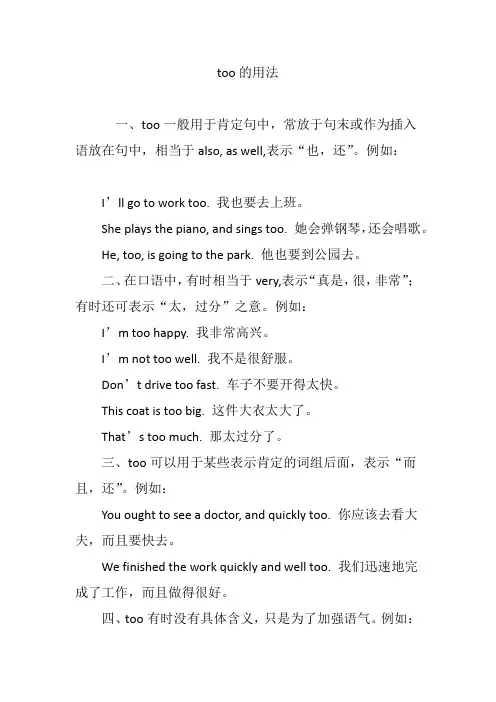
too的用法一、too一般用于肯定句中,常放于句末或作为插入语放在句中,相当于also, as well,表示“也,还”。
例如:I’ll go to work too. 我也要去上班。
She plays the piano, and sings too. 她会弹钢琴,还会唱歌。
He, too, is going to the park. 他也要到公园去。
二、在口语中,有时相当于very,表示“真是,很,非常”;有时还可表示“太,过分”之意。
例如:I’m too happy. 我非常高兴。
I’m not too well. 我不是很舒服。
Don’t drive too fast. 车子不要开得太快。
This coat is too big. 这件大衣太大了。
That’s too much. 那太过分了。
三、too可以用于某些表示肯定的词组后面,表示“而且,还”。
例如:You ought to see a doctor, and quickly too. 你应该去看大夫,而且要快去。
We finished the work quickly and well too. 我们迅速地完成了工作,而且做得很好。
四、too有时没有具体含义,只是为了加强语气。
例如:I will too go!我要去的!五、too不能用于very, fairly和quite后面,但它前面可以用a bit, a little, a lot, rather, much等表示程度的词来修饰。
例如:It’s much too cold, today. 今天天气太冷了。
He’s rather too sure of himself. 他未免有点太自信了。
比较下面的例句:You gave him too much.I’m much too busy.too much意为“太多,太过分”,可以用在不可数名词前,也可用作代词或副词,后面不接名词。
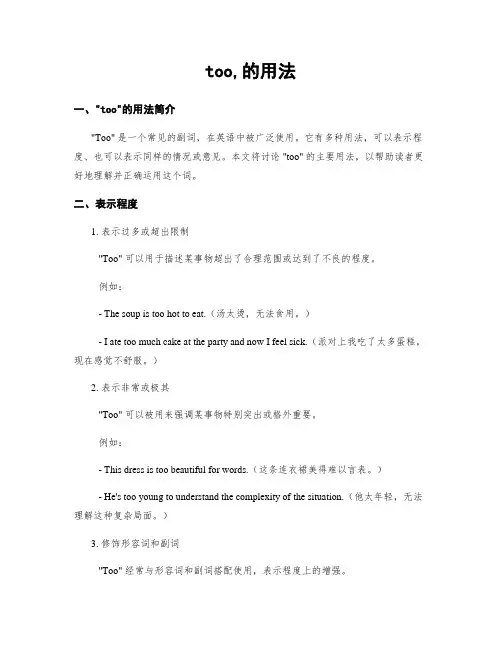
too,的用法一、"too"的用法简介"Too" 是一个常见的副词,在英语中被广泛使用。
它有多种用法,可以表示程度、也可以表示同样的情况或意见。
本文将讨论 "too" 的主要用法,以帮助读者更好地理解并正确运用这个词。
二、表示程度1. 表示过多或超出限制"Too" 可以用于描述某事物超出了合理范围或达到了不良的程度。
例如:- The soup is too hot to eat.(汤太烫,无法食用。
)- I ate too much cake at the party and now I feel sick.(派对上我吃了太多蛋糕,现在感觉不舒服。
)2. 表示非常或极其"Too" 可以被用来强调某事物特别突出或格外重要。
例如:- This dress is too beautiful for words.(这条连衣裙美得难以言表。
)- He's too young to understand the complexity of the situation.(他太年轻,无法理解这种复杂局面。
)3. 修饰形容词和副词"Too" 经常与形容词和副词搭配使用,表示程度上的增强。
例如:- She is too kind to refuse any favors.(她太善良了,不会拒绝任何人的请求。
) - The movie was too loud, so I couldn't hear the dialogue clearly.(这部电影声音太大了,我听不清对话。
)三、表示同样的情况或意见1. 表示也"Too" 有时可以表达与前面说话者相同的感受、情况或意见。
例如:- I'm hungry. Are you too?(我饿了。
你也饿吗?)- Sarah likes traveling, and I do too.(莎拉喜欢旅行,我也是。

英语too的用法1. Too作为副词,表示"也",用于肯定陈述中,通常放在句子的末尾。
- I like basketball too.(我也喜欢篮球。
)- She is going to the party too.(她也要去参加聚会。
)2. Too作为副词,表示"过分地",用于修饰形容词或副词,表示程度过高。
- The water is too hot to drink.(这水太烫,无法饮用。
)- She runs too quickly for me to catch up.(她跑得太快了,我追不上她。
)3. Too作为副词,表示"还",用于否定陈述中,表达某种反向情感。
- He didn't stay too long.(他没待太久。
)- They didn't complain too much.(他们没有抱怨太多。
)4. Too作为形容词,表示"过度的"或"过分的",与名词连用。
- The dress is too expensive for me to afford.(这条裙子对我来说太贵了,买不起。
)5. Too作为连词,表示"也",起连接两个并列句的作用。
- She not only likes to read novels, but she also enjoys watching movies.(她不仅喜欢读小说,而且也喜欢看电影。
)注意事项:- Too通常放在句末,但如果修饰的是形容词或副词,可以放在其前面。
- 在简短的问句中,通常直接将too放在句末,表示肯定回答。
- Do you like ice cream? Yes, I do too.(你喜欢冰淇淋吗?是的,我也喜欢。
)- 在否定陈述中,使用not too可以表示"并不"的意思。
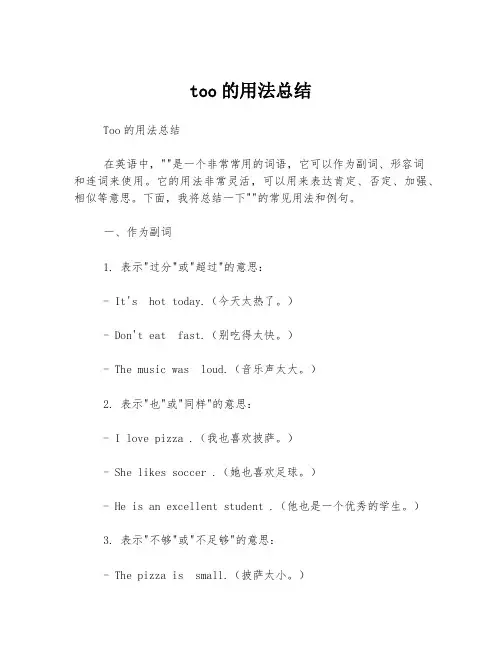
too的用法总结Too的用法总结在英语中,""是一个非常常用的词语,它可以作为副词、形容词和连词来使用。
它的用法非常灵活,可以用来表达肯定、否定、加强、相似等意思。
下面,我将总结一下""的常见用法和例句。
一、作为副词1. 表示"过分"或"超过"的意思:- It's hot today.(今天太热了。
)- Don't eat fast.(别吃得太快。
)- The music was loud.(音乐声太大。
)2. 表示"也"或"同样"的意思:- I love pizza .(我也喜欢披萨。
)- She likes soccer .(她也喜欢足球。
)- He is an excellent student .(他也是一个优秀的学生。
)3. 表示"不够"或"不足够"的意思:- The pizza is small.(披萨太小。
)- The shirt is tight.(衬衫太紧。
)- The book is expensive.(这本书太贵了。
)4. 表示"一起"或"同时"的意思:- Let's go to the movie .(我们也去看电影吧。
)- Can I come ?(我可以一起来吗?)- Are you going to the party ?(你也去参加派对吗?)5. 表示"非常"或"极其"的意思:- She is kind.(她非常善良。
)- The dog is cute.(这只狗太可爱了。
)- I am tired to go.(我太累了,不能去。
)二、作为形容词1. 表示"超级的"、"极其"或"很"的意思:- The cake was sweet.(这个蛋糕太甜了。
too 用法too 用法:1.当用来修饰形容词或副词时,它表示程度过大,相当于中文里的“太”、“过”或“过度”。
例如:"The dress was too tight for me." 表示这条裙子对我来说太紧了。
2.在肯定句中,当"too" 后接形容词或副词以及不带to的不定式时,可以构成一个否定意义的短语,意味着某事物或行为是不适宜的或不足以满足需求。
"Too + 形容词/副词+ to + 不带to的不定式" 这个结构表达的是过度的意思,如:"He earns too little to keep his family in comfort." 表示他赚得太少了,无法让家人过上舒适的生活。
3."Too" 可以放在句首以引起注意,用于强调某个不寻常或不希望的情况,但这种用法不如放在句末常见。
4.另一个固定句式是"too + 形容词/副词+ to + 带to的不定式",这个结构通常用于表达能力不足或资源不够,如:"His hands are too weak to cock his revolver." 表示他的手无力到无法扣动左轮手枪的扳机。
5.另外,"too" 作为副词,还有其他多种用法,如"too young"、"too bad"、"too early"、"too slow"、"too expensive"、"too curious"、"too beautiful" 等,这些都是描述状态或特征的词汇。
too的用法总结大全(实用版)编制人:__________________审核人:__________________审批人:__________________编制单位:__________________编制时间:____年____月____日序言下载提示:该文档是本店铺精心编制而成的,希望大家下载后,能够帮助大家解决实际问题。
文档下载后可定制修改,请根据实际需要进行调整和使用,谢谢!并且,本店铺为大家提供各种类型的实用资料,如工作报告、合同协议、条据文书、策划方案、演讲致辞、人物事迹、学习资料、教学资源、作文大全、其他资料等等,想了解不同资料格式和写法,敬请关注!Download tips: This document is carefully compiled by this editor. I hope that after you download it, it can help you solve practical problems. The document can be customized and modified after downloading, please adjust and use it according to actual needs, thank you!Moreover, this store provides various types of practical materials for everyone, such as work reports, contract agreements, policy documents, planning plans, speeches, character stories, learning materials, teaching resources, essay encyclopedias, and other materials. If you want to learn about different data formats and writing methods, please pay attention!too的用法总结大全too的用法你知道哪些?今天本店铺给大家带来了too的用法,希望能够帮助到大家,下面本店铺就和大家分享,来欣赏一下吧。
too too 用法tootoo有三种基本用法,即作副词、用于连接代词和动名词或动词时,作定语,作表语。
一、用作副词:当too出现在句中作状语时,主要用于强调下列几种情况: 1、当系动词+ too结构作状语时,通常用于现在完成时。
如: I tried too hard to study。
我努力学习。
2、当用于对过去发生事情的描述时,可以直接将其省略,意为“已经做了”。
如: He had too much money。
他有太多钱。
这两个句子通常出现在主语和谓语之间。
二、用于连接代词和动名词或动词时,通常是定语。
如: She took too many books。
She took too much。
三、 too用作表语,意为“太…;太…”,其后通常接名词或形容词。
如: You are too tired。
You are too old。
这些水果太酸了。
你太大了。
You're too shy。
你太害羞了。
She is too tall。
She is too thin。
你们太沉了。
The plane is too hot。
飞机上太热了。
She is too young。
她太年轻。
It's too hot。
天气太热了。
1、 to连接两个形容词或两个以上的名词或代词时,只能用too。
如: I was too afraid to go。
我太怕去了。
My mother had too much money。
我母亲有太多钱。
2、 too在定语从句中作表语时,必须用too,不能用to,如: The tree has to be cut too,or the leaves will grow too thick。
那棵树必须砍掉,否则树叶会长得太茂盛。
The ground will be too dusty to walk on。
地面会太脏而难以行走。
She is too young to have a baby。
too在句中的用法(一)Too在句中的用法1. 表示“也”•用于肯定句中,表示某人或某物也具有某种特征或能力。
–例:My sister can speak French, and I can too.(我的姐姐会说法语,我也会。
)2. 表示“过于”、“太过”•用于修饰形容词或副词,表示程度过高或超过一般范围。
–例:The coffee is too hot to drink.(咖啡太烫,不能喝。
)–例:She talks too fast for me to understand.(她说得太快,我听不懂。
)3. 表示“多余”、“不必要”•用于修饰动作或事物,表示该动作或事物是多余的,不必要的。
–例:We don’t need to buy another TV, the one we have is too.(我们不需要再买一台电视,我们已经有一台了。
)4. 表示“连……也”•在某些句型中,表示即使是某个人或某种情况,也适用于之后的描述。
–例:I was too tired to even walk.(我累得连走路都不行。
)–例:She is too busy to have time for a vacation.(她太忙了,没时间度假。
)5. 表示“表示惊讶”、“抱怨”或“不满”•用于感叹句或疑问句中,表示对某种情况感到惊讶、抱怨或不满。
–例:You haven’t started your homework yet? That’s too late!(你还没开始做作业吗?太晚了!)–例:He left the party early, and I was like, “Too bad! I wanted him to stay longer.”(他提前离开了派对,我感到很遗憾,我想让他再多待一会。
)6. 表示“不属于该范畴”•用于肯定句中,表示某人或某物不适合属于某个范畴。
–例:I love romantic comedies, but this movie is too dark for me.(我喜欢浪漫喜剧,但这部电影对我来说太黑暗了。
too在句中的用法和位置
1. “Too”可以放在句子末尾呀,就像“I like ice cream too.”(我也喜欢冰淇淋。
)你看,这多简单直接!
2. 咱还能把“too”放在形容词或副词前呢,比如说“He is too tall.”(他太高了。
)是不是很容易理解呀?
3. 哎呀呀,当你想表达“也一样”的时候,“too”就派上用场啦,像“She likes dancing, and I like it too.”(她喜欢跳舞,我也喜欢。
)
4. 有时候啊,“too”能强调程度呢,就像“This coffee is too hot.”(这咖啡太热了。
)能体会到那种感觉不?
5. 你们想想,“too”是不是也能在否定句里出现呀,例如“I don't want to go there too.”(我也不想去那儿。
)是不是挺有意思的?
6. 要是想说“太……以至于不能”,那“too...to”可就登场啦,像“He is too tired to walk.”(他太累了以至于不能走路。
)这可常用哦!
7. 哈哈,最后提醒一下哟,可别用错地方啦,就像你总不能说“I too like it.”(这可不对哦!)要记住正确用法呀!
总之,“too”的用法很丰富呢,记住这些,用起来就会得心应手啦!。
too在句中的用法"too" 是一个常用的副词,用来表示过量或者超过某个限度。
它可以用在肯定句、否定句、问句或条件句中,传达不同的含义。
下面将通过一篇生动、全面、有指导意义的文章来介绍"too"在句中的不同用法。
标题:发现"too"的魅力:用好副词提升语言表达力导语:副词"too"在句中的用法多样,它能够增加句子的表达力和意义。
无论你是学习者还是母语使用者,了解和掌握"too"的用法对于提高语言水平都是至关重要的。
本文将详细介绍"too"的用法,并给出相关的例句和使用指导,希望能够帮助读者更加准确地运用这个副词。
一、在肯定句中的用法:1. 表示程度"Too"用于肯定句中时,表示程度的强调或者超出一定限度。
例如:The cake is too sweet.(这块蛋糕太甜了。
)这句话中,"too"强调了蛋糕的甜度超过了可接受的限度。
2. 表示加入或者参与"Too"还可以表示添加或者参与的一种意思。
例如:Could you pass me the salt, too?(你也能给我递一下盐吗?)这句话中,“too”表示请求对方将盐也递给自己。
二、在否定句中的用法:1. 表示否定意义的强调"Too"在否定句中强调某种不适宜或者不合理的情况。
例如:Ican't eat too much sugar.(我不能吃太多的糖。
)这句话中,“too”强调了因为某种原因,自己不能吃太多的糖。
2. 表示与某人或某事不符合"Too"也可以表示与某些特定事物不符合。
例如:This coat istoo small for me.(这件外套对我来说太小了。
)这句话中,“too”表示这件外套不适合自己。
三、在问句或条件句中的用法:1. 表示询问对方意见或者决定"Too"可以用来征求对方的意见或者决定。